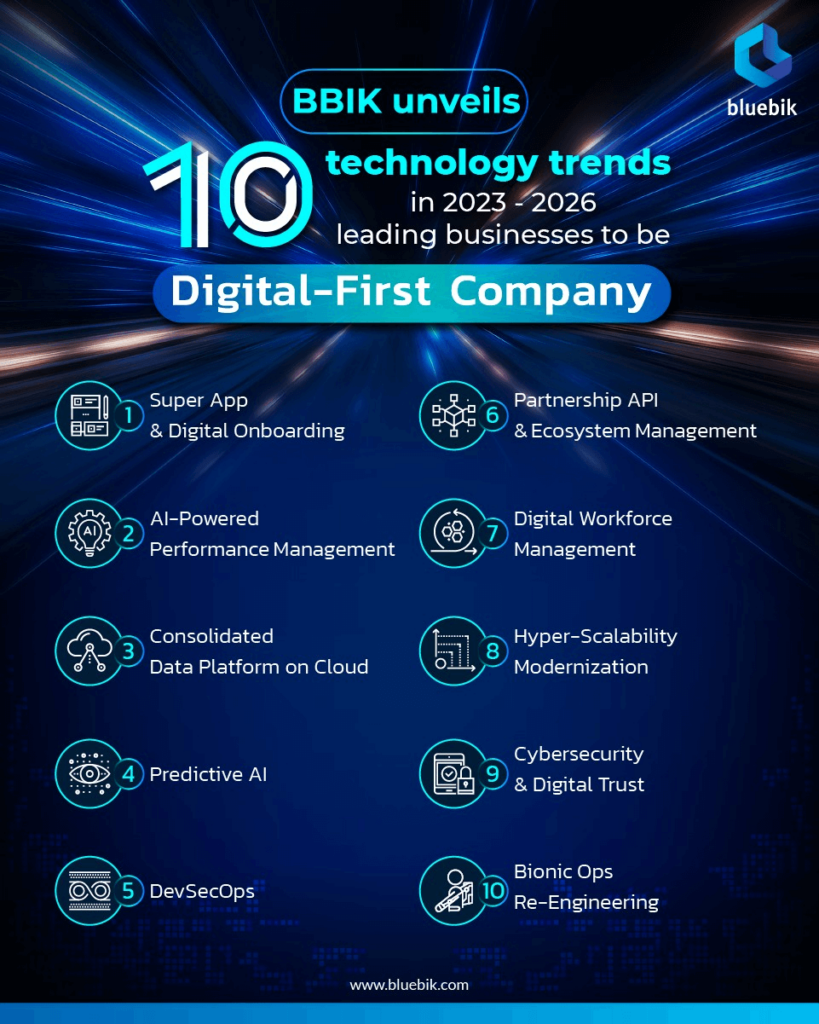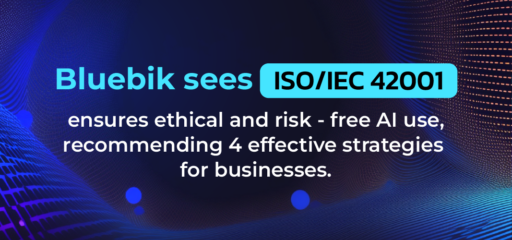Bluebik suggests 10 disruptive technology trends in 2023 – 2026, urging businesses to become “Digital-First Company” with 3 factors to be competitive enough amid economic fluctuations
Bluebik Group Public Company Limited (BBIK), a leading consultancy on end-to-end digital transformation, seesthat although the COVID-19 pandemic has improved, businesses cannot become complacent because next crises are arising. They are political uncertainties, global economic fluctuations and problems about supply chains, rising inflation and the liquidity of financial institutions. Under these circumstances, businesses will face fierce competition amid economic recession and only strong and agile organizations will survive.
Mr. Pochara Arayakarnkul, Chief Executive Officer of Bluebik Group Public Company Limited, said that from now on innovation and technology will be applied seriously and digital transformation must be carried out continuously and extensively enough to turn organizations into “Digital-First Company”. This is the trend of the business organizations that will survive and grow despite economic slowdowns. To ensure sustainable growth, businesses must be able to use technology suitably to cope with changes, cut administrative costs, follow the trends of online business which is becoming a main channel of sales and communicate with Generation M (Millennials) and Generation Z (Zoomers) – the target groups that have the highest purchasing power.
Digital-First Company, now the key to organizations’ success
To be Digital-First Company, organizations must revise all aspects of their business. This concerns technology application, work processes and organizational structures. However, the revision does not always means change. Actually, it relates to suitable and responsive adaptation and technology application to cope with changes or crises and create growth opportunities. Being Digital-First Company, organizations are flexible and ready to improve their work processes to be efficient and able to deal with the changing world of business. The following factors contribute to Digital-First Company.
- Digital-first strategy – This is to find a business model that will lead to exponential growth. The model includes technology application to increase the value of products and services.
- Digital-first people – Employees must have the mindset of digital native business. Executives set goals and stimulate employees to change their attitudes and accept digital work processes. Executives also devise RWA (ready, will and able) instruments to evaluate readiness and ability for adaptation through various activities and tailor digital culture development plans to suit different business units.
- Digital-first process – Work processes and systems are flexible with the Agile style of work that streamlines processes and supports the scalability of work systems through, for example, cloud computing.

Bluebik sees the 10 digital-first capabilities or10important technologiesthat will disrupt the business world. The company has experience and expertise in the 10 capabilities which make business organizations “Digital-First Company”.
1. Super app & digital onboarding – This is always a major technology trend. However, it is not easy to follow the trend because super app development requires core features, highly complicated systems and components related to microservices, data sharing and mini apps. Importantly super app development needs considerable funds and development expertise to ensure that a super app has scalability, extensibility, cybersecurity, maintainability, efficiency and update solutions to always satisfy users.
2. AI-powered performance management – This refers to the technologies that improve management. Artificial intelligence (AI) with automatic data processing and precise and real-time outputs helps business executives make right decisions. The AI includes the key performance indicator (KPI) and objective & key result (OKR) software which processes data in real time. Consequently, it can stimulate employees to work and ease executives’ workloads, for example.
3. Consolidated data platform on cloud – Many organizations are struggling to manage their data that are growing on a daily basis and have various forms and sources. The use of the precious data requires proper data storage and connection on an effective and user-friendly system. Therefore, cloud-based data storage and consolidation have been another major technology trend. Consolidated data platforms on cloud can be expanded and downscaled at will. They are flexible and can be used to produce detailed insights about target groups.
4. Predictive AI – This is to make use of data by analyzing them with highly sophisticated deep learning (DL) technology. For example, data are collected by IoT (Internet of Things) sensors and analyzed with DL to find precisely the Micro Moment Personalization of target groups. This increases revenue generation channels and brand loyalty and cuts marketing costs.
5. DevSecOps – It is the best way to boost efficiency in system and software development. It saves time in deployment and reduces problems during the process. Regulations or security procedures can be included in the DevOps process. Consequently, developed systems are efficient and secure and can allay growing concern about cybersecurity.
6. Partnership API & ecosystem management – Business organizations and partners connect their systems through application program interfaces and jointly manage their ecosystems to improve customers’ experiences and upgrade their cybersecurity. To ensure successful partnership API & ecosystem management, stakeholders must work out the connection plans that will result in mutual benefits. Also, they must choose suitable technologies and instruments and manage cybersecurity risks.
7. Digital workforce management – This refers to technology application for personnel management to pave the way for the stable operations and growth of organizations and to support new models of work such as hybrid working and remote working as well as coordination between internal and outsourced teams.
8. Hyper-scalability modernization – Technology is used to upgrade existing systems or applications so that they can smoothly handle more transactions in the future. Event Driven Nano Service Architecture (EDNA) improves the maintainability of applications and software, streamlines product development processes and allows teams to develop systems without restrictions because EDNA separates services and systems are more stable.
9. Cybersecurity & digital trust – The software and systems that are stable and secure are fundamental to business in the digital era because the cybersecurity and stability of systems and applications have impacts on customers’ confidence in organizations and brands. Digital trust is a requirement for Digital-First Company.
10. Bionic Ops Re-Engineering – Human abilities and mechanics integrate with each other to enhance efficiency in work processes. For example, robotic process automation (RPA) enables business organizations to build robots and use them to perform repetitive tasks in place of humans and low-code platforms are used for faster and easier coding.
“Business growth in the digital world requires new strategies and new business models as well as abilities to quickly adapt to changes in order to maintain competitiveness and achieve new S-curve growth. Technology application must be planned with visions and suit business strategies and economic trends. This makes Bluebik determined to continuously expand its business and strengthen its end-to-end services to be able to help clients cope with changes and fluctuations and prepare them for growth opportunities in the future,” Mr. Pochara concluded.




